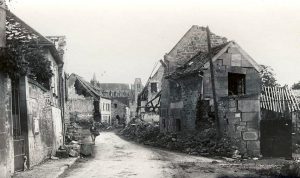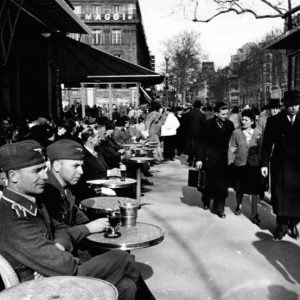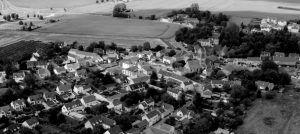A Letter from Paris 1944 – Mme Hélène Sergejew
Recently discovered letter from Occupied France – How civilians risked their lives protecting allied servicemen – in her own words.
A Letter from Paris – 1944.
Recently discovered letter by a brave Russian lady and her family who saved a young British airmen from enemy hands at the risk of their own safety.
Occupied Paris – German soldiers near Rue de Rivoli – 1943
Madam Helene Sergejew,
60, Rue de Provence,
Paris. 9e.
November 1944
Dear Mrs Phelps,
I would have liked to send you this letter immediately after making your son’s acquaintance;
I would have liked it to reach you before the news of the loss of your son’s plane, but, of course, it was impossible. Poor boy, he was very upset at not being able to send you the news that he was alive and we were unable to help him.
I will tell you how he came to us on Friday, July 7th, 1944. Our village is called Hérouville and is 40kms from Paris in the county of Seine et Oise. During the night of the 7th and 8th July, at 2am double summer time, we were awakened by the loud noise of aeroplane’s engines.
We supposed, of course that a large squadron was passing over the house, and then the house began to shake and bombs dropped.
Our rooms were quite lit up by rockets; it was a very impressive and unforgettable sight. We ran out onto the balcony and into the garden; the sight was dreadful. They were bombing L’Isle-Adam where there was a Flying-Bomb base, 7km from us, but it seemed as if everything was taking place in out garden. The anti-aircraft guns were firing, bombs were flying, fires had broken out and aeroplanes on fire were falling. Suddenly the house shook from an awful blow, and it looked as if a huge column of fire was rising nearby.
It was Keith’s York [Lancaster] falling in a field 500 metres from out village and a little off, fell two German planes. All this was burning and smoking and smelt of fire, and was terribly impressive. However, the battle calmed down and only some time-bombs were heard. We went back to our rooms, but I hadn’t even time to shut my eyes when the dog’s bark was heard and a noise in the yard. It was 3:30am.
Through the window my husband and I saw a man looking for the door in the dark and when he saw us he said “English”. In a second we were downstairs. I opened the door and your son entered the house. He was hurt, as he had thrown himself out of the plane 2 seconds too late. He had no shoes; he was very scratched, but, thank goodness, not wounded. We asked him as well as we could what he intended doing, and he answered “Normandy”, evidently thinking that it was not far off.
Then we decided to hide him, although we knew that we might be shot. At the same time we were glad we could help a man from the other side of the Front, where we were heart and soul all the time in our thoughts.
After having installed him, out of prudence in the straw in the garage, I listened all night for the German patrol, the cars of whom were passing all the time in search of parachutists, and towards morning, I heard steps of German soldiers coming towards our house. I was terribly frightened, but they passed by without entering.
On Saturday evening, we brought Keith into the house, gave him civilian clothing and put him in our son’s room as one of his friends, but hiding him from the servant and neighbours was difficult and dangerous, the more so as we had to return to Paris and we decided to take him with us. This journey with him I shall also never forget. It was frightening to go with him through the village, to take the train, to go through Paris, but there also, everything went well.
We brought him to Paris on Monday July 10th, late at night and Keith spent the night at our flat, and on the next day, Tuesday, July 11th, we handed him over to a secret organisation helping parachutists to return to England. After that we were told that he was sent to England by plane on the 12 with a group of other pilots. Is that so?
The fate of the other members of the crew of the York [Lancaster] is the following:
The first to jump out fell in the next village, Ennery, 4 kms from us and was hidden by the people there.
The second, as I wrote, was Keith.
The third was not so lucky. His parachute hadn’t time to open and his body was found not far off from the plane by the inhabitants from the nearby village, Anvers-sur-Oise, and was buries in the local cemetery. The Allied flags were brought out; the grave was covered with flowers. The Germans heard of that, arrested 20 men and treated than in a brutal manner. Some of their eyes were knocked out, others their arms broken, or feet, or ribs. The flowers and grave they destroyed, trod down and despoiled. The other members of the crew were brought down with the plane.
Please write to us about your son. Did he arrive safely and when? We all got fond of him as one of the family and we speak of him very often. When the War is over, we hope he will come and see us in Paris, and if my son goes to England he won’t fail to go and see you. Please send us detailed news of Keith; we shall wait impatiently for your letter. We beg to give our best remembrance to Keith and we send our heartiest regards. May God bless you all.
Yours very sincerely,
Helene Sergejew.
P.S. We are Russian emigrants living in France since the Russian Revolution. In Paris we make ladies scarves and own the “Maison Elliks”, 60 rue de Provence, Paris 9e.
Hérouville in the Val-d’Oise department of Île-de-France in northern France
Historic Note:
Lancaster Mk.I, LM129 EM-Y of No. 207 Squadron RAF set off from its base at RAF Spilsby in Lincolnshire on the evening of 7th July. It was attacked by a Luftwaffe night fighter and crashed near Herouville by the road to Auvers-sur Oise, north western outskirts of Paris.
The pilot, Flying Officer C.E. Stamp plus the rear gunner and mid upper gunner Sgt. R.G. Seddon and Sgt. J Marwood were killed. The rest of the crew: Flight Sergeant J.E. Fisher, Flying Officer A.E.J. Gilby; Sgt K.A. Ward and Sgt E.Keith Phelps, survived either as prisoners of war or evaded capture. (A total of 5 Lancasters based at RAF Spilsby were also lost that night– the highest number lost by 207 Squadron on a single mission).
AVRO Lancaster bombers outward bound 1945
The first German V1 flying bomb fell in Britain on 13th June 1944, just one week after D-Day – the Allied Invasion of Normandy. Throughout June and July up to 100 flying bombs a day were fired at London and the south east with a total of 9521 being launched until the launching sites were overrun in October by Allied advances into Europe. A further 2448 were launched against allied troops particularly against Antwerp in Belgium and the Netherlands until the war’s end. The strategic effect and psychological pressure on the civilian population was such that a huge Allied effort was made to destroy the production and launching capacity, although it wasn’t until March 1945 that the last V2 bomb was to land in Britain.

V1 Flying bombs being prepared for launching
Beginning on the night of 4th/5th July RAF 5 Group RAF Bomber Command undertook three raids on the V1 storage and assembly areas in the caves (formerly used for mushroom growing) at the small town of St Leu d’Esserent (German Codename: “Leopold”), near Criel, north of Paris. Initial daylight raids by the USAAF in June had been unsuccessful.

The remains of the town of St Leu d’Esserent – July 1944
Operation St Leu 7/8 July 1944
This raid was one of the biggest battles over the skies of France in World War II.
Bomber Command sent 208 Lancaster heavy bombers and 13 Mosquito “pathfinders”. Visibility was good with a full moon and after several previous raids and the continued restoring of the V1 depot, the Luftwaffe was expecting the RAF to return and was fully prepared. Deception plans to attack alternate sites nearby and thus pull Luftwaffe night fighters away from the main target did not work.
32 Lancaster bombers, each with 7 crew, were shot down.
RAF losses:
Lancaster JA690 9 Sqd RAF Bardeny
Lancaster JA957 9 Sqd RAF Bardeny
Lancaster JB116 9 Sqd RAF Bardeny
Lancaster ME634 44 Sqd RAF Dunholme Lodge
Lancaster ME859 44 Sqd RAF Dunholme Lodge
Lancaster LM631 44 Sqd RAF Dunholme Lodge
Lancaster LL976 49 Sqd RAF Fiskerton
Lancaster LM541 49 Sqd RAF Fiskerton
Lancaster PB207 49 Sqd RAF Fiskerton
Lancaster DV363 50 Sqd RAF Skellingthorpe
Lancaster DV227 50 Sqd RAF Skellingthorpe
Lancaster PA996 50 Sqd RAF Skellingthorpe
Lancaster ME868 57 Sqd RAF East Kirby
Lancaster JB370 57 Sqd RAF East Kirby
Lancaster LM522 57 Sqd RAF East Kirby
Lancaster R5856 61 Sqd RAF Skellingthorpe
Lancaster ND867 61 Sqd RAF Skellingthorpe
Lancaster ND966 83 Sqd RAF Coningsby
Lancaster ME668 106 Sqd RAF Metheringham
Lancaster ME789 106 Sqd RAF Metheringham
Lancaster ME831 106 Sqd RAF Metheringham
Lancaster JB641 106 Sqd RAF Metheringham
Lancaster PB144 106 Sqd RAF Metheringham
Lancaster LM129 207 Sqd RAF Spilsby
Lancaster LM218 207 Sqd RAF Spilsby
Lancaster ME805 207 Sqd RAF Spilsby
Lancaster ND567 207 Sqd RAF Spilsby
Lancaster ND866 207 Sqd RAF Spilsby
Lancaster LM219 467 Sqd RAF Waddington
Lancaster LM338 467 Sqd RAF Waddington
Lancaster ME745 619 Sqd RAF Dunholme Lodge
Lancaster NE688 630 Sqd RAF East Kirby
FIN
Note: This story is still being researched with a view to discovering the families concerned.



